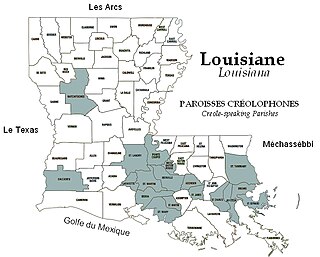 W
WLouisiana Creoles are persons descended from the inhabitants of colonial Louisiana during the period of both French and Spanish rule. Ancestry of Louisiana Creoles as an ethnic group are mainly French, African American, Spanish and/or Native American. Other contributing ancestry can include Chinese, Italian, German, Japanese, Filipino and/or Irish. Louisiana Creoles share cultural ties such as the traditional use of the French, Spanish, and Louisiana Creole languages and predominant practice of Catholicism.
 W
WCajun fiddle music is a part of the American fiddle music canon. It is derived from the music of southwest Louisiana and southeast Texas, as well as sharing repertoire from the Quebec and Cape Breton Island traditions. It is one of the few extant North American folk music traditions rooted in French chanson. According to Ron Yule, "Louisiana fiddling had its birth roots in Europe, with fiddling being noted as early as the 1400s in Scotland". Zydeco music is a geographically, culturally, and musically related style.
 W
WEstablished in 1994, the Cane River Creole National Historical Park serves to preserve the resources and cultural landscapes of the Cane River region in Natchitoches Parish, Louisiana. Located along the Cane River Lake, the park is approximately 63 acres and includes two French Creole cotton plantations, Oakland and Magnolia. Both plantations are complete in their historic settings, including landscapes, outbuildings, structures, furnishings, and artifacts; and they are the most intact French Creole cotton plantations in the United States. In total, 65 historic structures and over a million artifacts enhance the National Park Service mission as it strives to tell the story of the evolution of plantation agriculture through the perspective of the land owners, enslaved workers, overseers, skilled workers, and tenant farmers who resided along the Cane River for over two hundred years. This park is included as a site on the Louisiana African American Heritage Trail.
 W
WThe term Creole music is used to describe both the early folk or roots music traditions of rural Creoles of Louisiana.
 W
WThe Grandissimes: A Story of Creole Life is a novel by George Washington Cable, published as a book in 1880 by Charles Scribner's Sons after appearing as a serial in Scribner's. The historical romance depicts race and class relations in New Orleans at the start of the 19th century, immediately following the Louisiana Purchase in 1803. The book examines the lives and loves of the extended Grandissime family, which includes members from different races and classes in Creole society. The novel juxtaposes a romanticized version of the French Creole culture with the atrocities committed under the European-American system of slavery in the United States.
 W
WLaura Plantation is a restored historic Louisiana Creole plantation on the west bank of the Mississippi River near Vacherie, Louisiana, (U.S.), open for guided tours. Formerly known as Duparc Plantation, it is significant for its early 19th-century Créole-style raised big house and several surviving outbuildings, including two slave cabins. It is one of only 15 plantation complexes in Louisiana with this many complete structures. Because of its historical importance, the plantation is on the National Register of Historic Places. The site, in St. James Parish, Louisiana, is also included on the Louisiana African American Heritage Trail.
 W
WLouisiana Creole or Kouri-Vini is a French-based creole language spoken by fewer than 10,000 people, mostly in the state of Louisiana. It is spoken today by people who racially identify as white, black, mixed, and Native American, as well as Cajun, Louisiana Creole, and African American, and should not be confused with its sister language, Louisiana French, which is a dialect of the French language.
 W
WLouisiana Creole cuisine is a style of cooking originating in Louisiana, United States, which blends West African, French, Spanish, Amerindian influences, as well as influences from the general cuisine of the Southern United States.
 W
WA vest frottoir or rubboard is a percussion instrument used in zydeco music similar to a washboard. It is usually made from pressed, corrugated stainless steel and is worn over the shoulders.